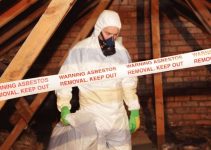How Do We Test for Asbestos at Home?
Asbestos at home is more common than we might think.
This is why learning about asbestos and how to identify and test it at home is so important. But before we dive into the how's, let's get a better understanding of what asbestos is.
What is Asbestos?
Asbestos is a natural mineral. It is usually composed of thin fibers which are packed tightly.
Because of its tightly packed fibers, it is a strong mineral that is used in manufacturing and constructing materials.
However, based on research, asbestos is dangerous to our health. It poses a serious health risk when the fibers of asbestos become airborne and are inhaled. When one inhales the loose fibers of asbestos, this can cause scarring of the tissue linings of organs, most commonly, the lungs.
When not detected and treated early, this can cause cancer and other serious health issues.
Hire an Expert to Check for Asbestos at Home
There are a lot of common household items that may possibly contain asbestos. Testing should be done in order to avoid exposure and it should be done by licensed professionals.
Remember that it is best to hire a licensed professional to check for asbestos at home. They know the correct procedures and protocols to repair and remove the materials containing asbestos. This is also to ensure your and your family's safety.
Asbestos that is lurking in materials and building constructions may not pose a risk. However, once disturbed, its dust and particles can then become dangerous.
Let's dive into common household items that may contain asbestos.

Where You Might find Asbestos at Home
It is not a clear and easy process to find asbestos at home.
This is because asbestos is not easily identifiable due to its fibrous material. But it is best to be knowledgeable of the possible materials that may contain this harmful mineral.
Below are a few of them:
Household Items That May Contain Asbestos
- Vinyl floors
- Floor tiles, roofing tiles, and textiles
- Ceiling insulation cavities
- Wallboards and wallboard joint compounds
- Insulation around heating pipes
- Garage roofs or shed roofs
- Coatings on ceilings, walls, or roofs
- Loose ceiling or floor cavities
- Gutter
- Old appliances
Now that we've had a better understanding of asbestos and possible places to find them, here's how to test for asbestos at home.
Again, it is best to call a professional to do this. But knowing the process is essential as well.
How to Test for Asbestos At Home
Do not disturb the area of testing for asbestos at home.
When you suspect asbestos in a certain place or material at home, do not attempt to clean it. Sweeping, vacuuming, wiping, or touching it can cause the dust particles to loosen and spread. This makes it more dangerous.
When checking for asbestos, ensure that there is still air around the area. This will ensure that the dust does not scatter.
It is best to shut all the windows and doors. Additionally, turn off any fans, heaters, or air conditioning to avoid circulating of the air.

Wear proper protective gear when checking for asbestos at home.
When checking for possible asbestos at home, it is best to wear protective gear. Use a face mask, gloves, overall coverups, and shoe covers. Additionally, after checking for asbestos, be sure to dispose of your protective gear.
Make sure that whoever enters is also wearing the right protective gear.
Cover the place in plastic sheeting and spray all surfaces with water.
When you lay plastic sheeting around the work area, this will help catch any asbestos dust that may be flying around. Additionally, when you spray a mist of water around the area, the air becomes more humid and will help ensure that the dust is not disturbed. This will also help make the dust settle quickly.
Make sure to dispose of the plastic sheeting properly after this step.
Isolate a sample of the material and spray it with water.
It is important to get a sample of the material in order to test it. In order to minimize the exposure, spray the material with water to minimize dust particles from loosening.
The sample must weigh around 5 grams to 100 grams. After spraying the material, mist the air around you as well.
Use pliers to transfer the sample.
When transferring the sample, use pliers to pick up the item. Additionally, it is best to place a wet wipe on the mouth of the pliers before picking up the sample. This way, the microscopic fibers won't stick to the mouth of the pliers.
Use this process when transferring the item to the protected ziplock bag.
Seal and label the bag.
It is important to securely seal the zip lock bag so that no fibers will escape. Additionally, make sure to label it properly for others to know that the items inside are hazardous.
When labeling the bag include the date when the sample was taken and where it was taken from.
Clean and vacuum the area.
After gathering the sample, clean the area where the sample was taken using a vacuum. Make sure to also use a wet rug to prevent the particles from becoming airborne.
Dispose of the rugs and any other materials used to clean the area. When disposing of the bag or rugs, make sure to seal them properly.
Send the collected sample to a certified laboratory.
Check the website of the National Voluntary Laboratory Accreditation Program. You'll be able to find a list of EPA-certified asbestos-testing labs.
Once you submit your sample to the lab, it takes a few weeks before getting the results.
In Conclusion
Finding out if your house contains asbestos is essential to prevent mesothelioma and other types of sicknesses caused by asbestos exposure. But always remember to hire a professional to test for asbestos at home.


